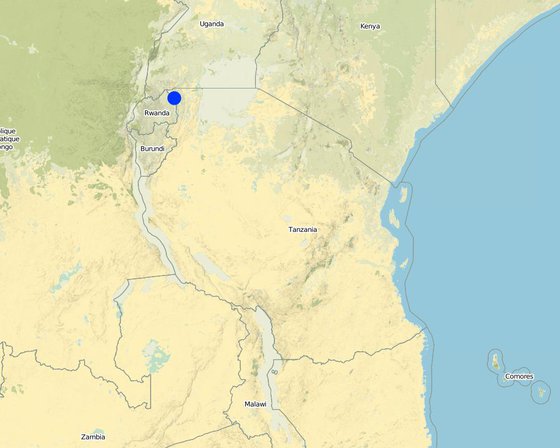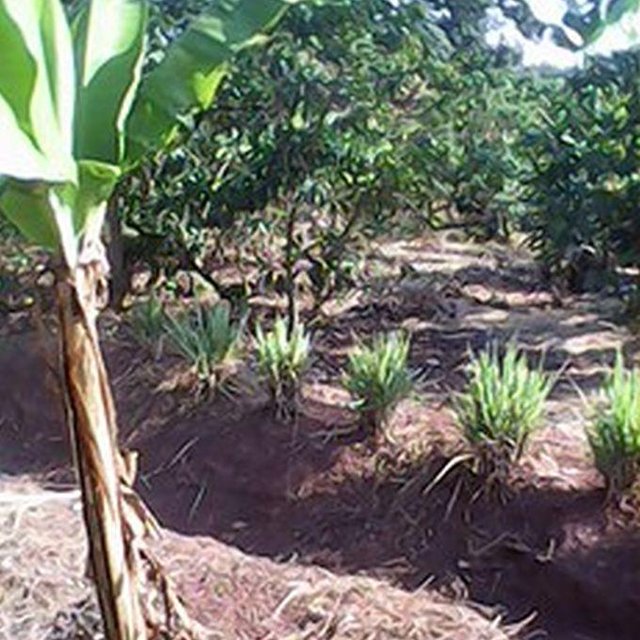

This conservation measure is used in BXW epidemically affected areas. Land users in affected areas are trained on the principle behind the diseases and means and ways to overcome it. Banana plants in seriously affected farms are uprooted and destroyed and non disease host crops usually maize and common beans are grown for starvation and destruction of BXW pathogen. The land is not used for banana production for a period of 6 months and instead substitute crops ensures food and income security to land users. Leguminous cover crops (beans) and crop residual management skills applied on the farm revitalize the soil health in terms of biomass, moisture and nutrient recycling. After 6 months, banana production is resumed where production is based on recommended husbandry practices combined with SLM conservation measures. The use of certified banana cultivars, optimal plant geometry and disease control cultural practices are some of the basic recommendation. Certified banana cultivars are planted at a space of 3m x 3m. The size of a hole used to plant banana is 0.9x0.9 m wide and 0.6 deep. During digging top soil is separated from subsoil. 2 -3 tins of manure are mixed with the top soil and the mixture is put in the bottom of the hole. The holes are left for microbial decay to take place and banana planting is done after 1 or 2 months. The tied Fanya chini water retention ditches are water harvesting and conserving structures constructed by digging trenches along the contour where dug soil is thrown to the lower side to form an embankment that prevents soil from falling back in. A-FRAME method is used to mark a contour line and on the other hand ARM OUTSTRETCHED LEVEL method determines how far apart the Fanya chini retention ditch should be. Unlike other retention ditches, the dug ditches are not continuous but instead are tied at regular interval with small cross–ties of 0.4-0.6m length. Ties intercept the ditch at right angle to form a series of narrow rectangular segments of infiltration ditches each of 5 meters long, 0.6m wide and 0.6m deep arranged in series within a contour line. Ties helps to prevent irregular flow of runoff and to ensure an evenly distribution of captured water. Fanya chini embankments are stabilized by planting crops on them the common crops are pigeon pea (space used between plant is stand is 1m x 1m), lemon grass (30cm x 30cm) or pineapples (60cm x 60cm). Mulching is done using grasses. The dominant grass species used is Hyperrenia rufa where a mulching depth of 15 cm is used.
Purpose of the Technology: PURPOSE: Improved food and fodder productivity, soil moisture and water holding capacity, nutrient recycling, and organic matter content, biomass cycle, crop tolerance to drought, income and food security, poverty reduction and health. Prevent unproductive evaporation of green water, combating soil erosion by water runoff and biological degradation due the deadly BXW disease.
Establishment / maintenance activities and inputs: ESTABLISHMENT: procurement and mobilization of working tools, uprooting and destruction of infected plants in affected fields, land tilling and harrowing, planting of alternative crops or creation of a productive disease free buffer zone, temporal harvesting of maize and beans, land preparation/ demarcation and spacing of holes for resumed banana planting, digging holes, manure application before planting, banana planting, demarcation of contour line for construction of Fanyachini contours with ties, digging and construction of Fanya chini contours with ties, vegetative stabilization of Fanya chini bunds (using lemon grass, pineapples or pigeon pea), random planting of castor oil plants for future anchoring support of plants with heavy bunches and mulching application. MAINTENANCE: hand weeding to control noxious weeds combined with other pest and disease control (control of nematodes and weevils), de-suckering to leave the mother plant and two baby plants, de-trashing or trimming of unproductive leaves, regular removal/de-bud of inflorescence (male bud) using a forked wooden pole once the bunch is completed to prevent BXW transition through insect vector , recurrent manure application, removal of sediments and maintenance of Fanyachini bunds, harvest of bananas, maize, pineapples and pigeon pea. INPUTS USED: largely includes labour (strenuously varying from light, medium and heavy), tools (hand hoe, forked hole, machetes, sickles, spade, mattock and A-frame), seedlings; improved or certified banana varieties, pineapples suckers, lemon grass and castor oil, seeds (beans, maize and pigeon pea), farm yard manure and mulching materials (preferably Hyperennial spps).
Natural / human environment: NATURAL ENV: The land use type is cropland with annual, perennial and some fruit tree crops. The technology involves a combination of agronomic, vegetative, structural and management conservation measures. Management measure involves all activities related to temporal shift to alternative crops for making the farm disease hot free and for staving and destroying the disease pathogen. Climatic zone is sub-humid with an average of 210 days of growing period (LGP). Average slope category is gentle lying between 2-5%. A soil texture class is sandy loam with medium depth categories. HUMAN ENV: the level of mechanization is hand tools. Production system is mixed (both subsistence and market or commercial oriented). The average costs of inputs required is 3015.68 USD. Land ownership is largely individual not titled and partly communal.

Localização: Kyerwa District Council, Kagera Region Tanzania, República Unida da Tanzânia
Nº de sites de tecnologia analisados:
Difusão da tecnologia: Uniformemente difundida numa área (approx. 0,1-1 km2)
Em uma área permanentemente protegida?:
Data da implementação: mais de 50 anos atrás (tradicional)
Tipo de introdução









| Especifique a entrada | Unidade | Quantidade | Custos por unidade (USD) | Custos totais por entrada (USD) | % dos custos arcados pelos usuários da terra |
| Mão-de-obra | |||||
| Planting of lemon grass, pineapples and pigeon peas | persons/day | 5,0 | 2,353 | 11,77 | 100,0 |
| Demarcation of contour line | persons/day | 7,0 | 2,26857 | 15,88 | 100,0 |
| Digging and construction of Fanya | persons/day | 10,0 | 2,353 | 23,53 | 100,0 |
| Uprooting and destruction of infected banana plants | persons/day | 11,0 | 2,353 | 25,88 | 100,0 |
| Equipamento | |||||
| Procurement and mobilization of working tools | ha | 1,0 | 76,47 | 76,47 | 100,0 |
| Material vegetal | |||||
| Lemon grass and pidgeon seeds | kgs | 5,0 | 2,94 | 14,7 | |
| Pineapple seedlings | pieces | 513,0 | 0,0588304 | 30,18 | |
| Initial banana seedlings | pieces | 660,0 | 0,441181818 | 291,18 | |
| Maize and bean seeds | kgs | 81,0 | 0,947654 | 76,76 | 100,0 |
| Fertilizantes e biocidas | |||||
| Initial mulching application | bundles | 900,0 | 0,1764666 | 158,82 | |
| Initial manure application | tons | 28,0 | 10,084 | 282,35 | |
| Outros | |||||
| Labour: Land tilling and harrowing | persons/day | 11,0 | 2,353 | 25,88 | 100,0 |
| Planting of alternative crops | persons/day | 9,0 | 2,353 | 21,18 | 100,0 |
| Custos totais para a implantação da tecnologia | 1'054.58 | ||||
| Custos totais para o estabelecimento da Tecnologia em USD | 1'054.58 | ||||
| Especifique a entrada | Unidade | Quantidade | Custos por unidade (USD) | Custos totais por entrada (USD) | % dos custos arcados pelos usuários da terra |
| Mão-de-obra | |||||
| Land preparation, demarcation and spacing of holes for resumed banana planting | persons/day | 35,0 | 2,353 | 82,36 | 100,0 |
| Manure application before planting Banana | persons/day | 33,0 | 2,353 | 77,65 | 100,0 |
| Banana planting | persons/day | 13,0 | 2,353 | 30,59 | 100,0 |
| Recurrent mulching applicatio | persons/day | 6,0 | 2,205 | 13,23 | 100,0 |
| Material vegetal | |||||
| Mulching material | bundles | 900,0 | 0,176464 | 158,82 | 100,0 |
| Fertilizantes e biocidas | |||||
| Compost/manure | tons | 16,0 | 13,235 | 211,76 | 100,0 |
| Material de construção | |||||
| Labour: Maintenance of Fanya chini | persons/day | 3,0 | 2,353 | 7,06 | 100,0 |
| Labour: Weeding an thinning | persons/day | 12,0 | 2,05916 | 24,71 | 100,0 |
| Labour: Harvesting of maize and beans | persons/day | 12,0 | 2,05915 | 24,71 | 100,0 |
| Outros | |||||
| Labour: Hand weeding to control noxious weeds | persons/day | 15,0 | 2,353 | 35,3 | 100,0 |
| Labour: Regular removal/de-bud of inflorescence | persons/day | 15,0 | 2,353 | 35,3 | 100,0 |
| Labour: Recurrent manure application | persons/day | 22,0 | 2,353 | 51,77 | 100,0 |
| Labour: Banana harvesting | persons/day | 16,5 | 2,353 | 38,82 | 100,0 |
| Labour: Weeding and gap filling of lemon grass, pineapples and pigeon peas | persons/day | 7,0 | 2,353 | 16,47 | 100,0 |
| Labour: Harvesting of lemon grass, pineapples and pigeon peas | persons/day | 7,0 | 2,353 | 16,47 | 100,0 |
| Custos totais para a manutenção da tecnologia | 825.02 | ||||
| Custos totais de manutenção da Tecnologia em USD | 825.02 | ||||
Quantidade anterior à GST: 5 fingers
Quantidade posterior à GST: 12 fingers
Increased banana yield due to use of SLM and good husbandry practices
Quantidade anterior à GST: low
Quantidade posterior à GST: high
Risk due to low moisture
Quantidade anterior à GST: low
Quantidade posterior à GST: high
Caused by the use of mulching and manure
Quantidade anterior à GST: low
Quantidade posterior à GST: high
Income accrued from increased production and diversification to pineapples and lemon grass
Quantidade anterior à GST: low
Quantidade posterior à GST: high
Attributable to added tasks from use of SLM
Quantidade anterior à GST: low
Quantidade posterior à GST: high
Improved nutrition from e.g. introduction of pineapples
Quantidade anterior à GST: low
Quantidade posterior à GST: high
Use of FFS have induced togetherness and group working spirit
Quantidade anterior à GST: low
Quantidade posterior à GST: high
SLM knowledge and skills gained through FFS trainings
Quantidade anterior à GST: low
Quantidade posterior à GST: high
Indiscriminate participation of all genders, age and ethnicity
Initially the technology has resulted to increased production, diversification to production of other income generating crops and dietary enrichment crops. The overall result is farmers capacity to meet education and health expenses
Quantidade anterior à GST: high
Quantidade posterior à GST: low
Good looking banana bunches attract thieving
Quantidade anterior à GST: high
Quantidade posterior à GST: low
Use of mulching and water retension ditches
Quantidade anterior à GST: low
Quantidade posterior à GST: high
Following use of mulching and manure
Quantidade anterior à GST: 40%
Quantidade posterior à GST: 90%
Improved soil coved caused by the use of grass mulching
Controll of soil erosion attributable to use of mulching and construction of water retension ditches.
Quantidade anterior à GST: low
Quantidade posterior à GST: high
Use of luguminous plants, application of manure and mulching
Quantidade anterior à GST: low
Quantidade posterior à GST: high
Use of manure
Quantidade anterior à GST: 40%
Quantidade posterior à GST: 90%
Biomass result from use of mulching and improved managment of crop residuals
Increased richness of soil fauna caused by the use of manure
Quantidade anterior à GST: 0%
Quantidade posterior à GST: 95%
Control of BXW
Quantidade anterior à GST: high
Quantidade posterior à GST: low
Increased tolerance to drought and BXW infestation
Managment of crop residues and manure
Quantidade anterior à GST: low
Quantidade posterior à GST: high
Of the neighbouring Kashasha wetland
Quantidade anterior à GST: high
Quantidade posterior à GST: low
Attributable to use of closs slope barriers
Quantidade anterior à GST: high
Quantidade posterior à GST: low
Attributable to use of closs slope barriers